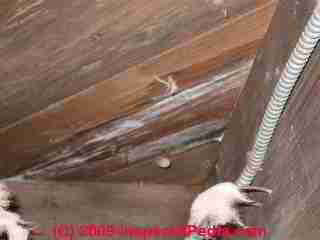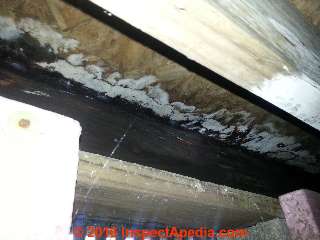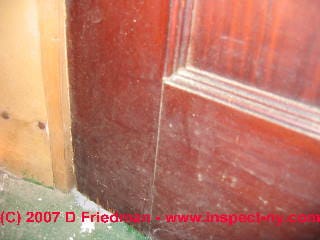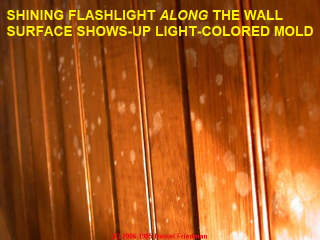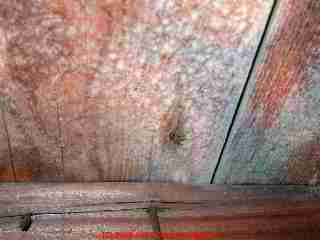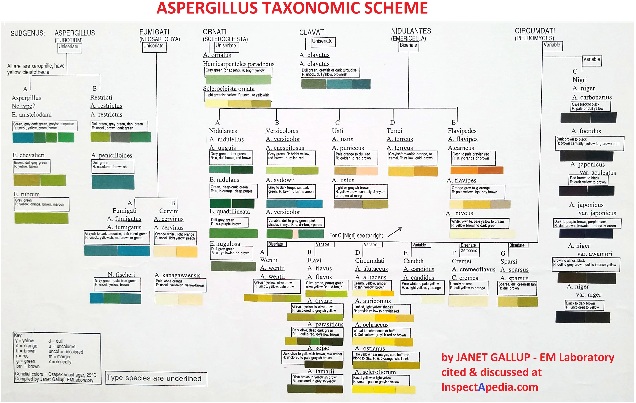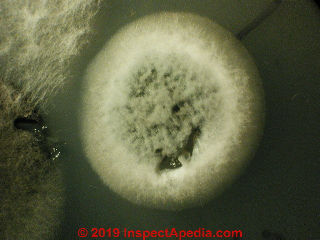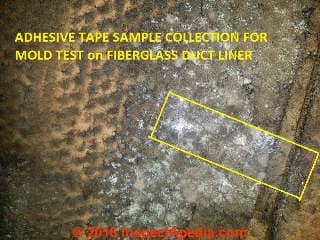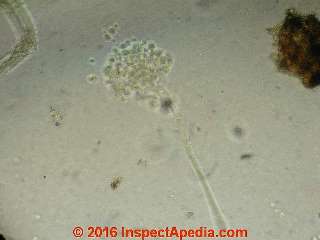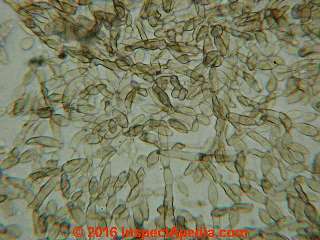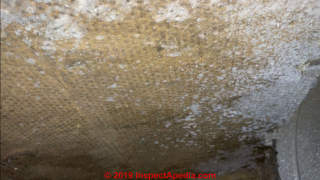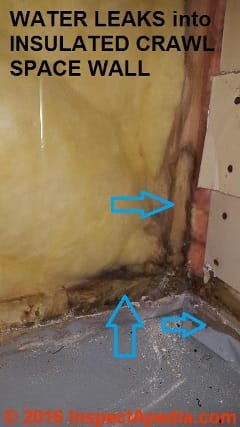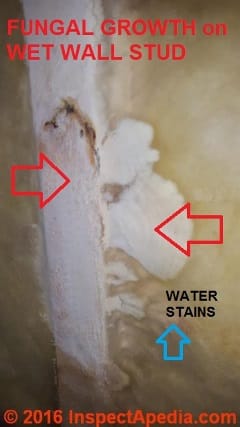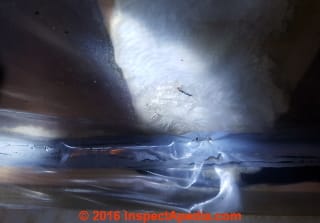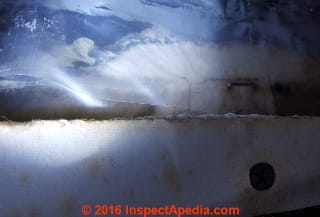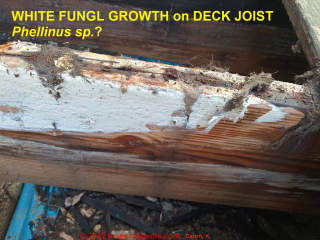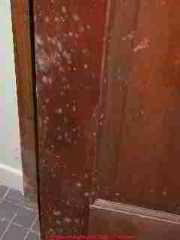 White Mold in the Home
White Mold in the Home
Detection and identification of white mold contamination in buildings - what white & light-colored mold looks-like
- POST a QUESTION or COMMENT about white or light colored mold growth in buildings
White building mold identification photographs: how to recognize white fungal mold growth.
What does white mold look like on building surfaces and how hard is this mold to see? Photos of white, gray, & light-colored mold in buildings - how to find & recognize mold on building surfaces.
These photos of mold on indoor building surfaces may help you recognize mold in buildings, recognize probably-cosmetic mold, and recognize stuff that is not mold and does not need to be tested.
Photographs of light colored mold & other molds of various colors and textures in buildings. Special methods needed to spot white & light colored mold growth indoors
InspectAPedia tolerates no conflicts of interest. We have no relationship with advertisers, products, or services discussed at this website.
Photographs Help Identify Mold in Buildings
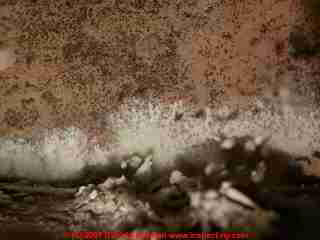 What white or light colored mold looks like in a home or in or on other buildings & building surfaces.
What white or light colored mold looks like in a home or in or on other buildings & building surfaces.
These mold samples and mold spores and their photographs and examples of materials sometimes mistaken for mold have been collected in the U.S., Spain, Mexico, France, as well as in other countries where I've studied bioaerosols.
[Click to enlarge any image]
For photos and an explanation of white fluffy stuff or white crystalline material often found on building walls, especially on masonry surfaces, but that is not mold,
see EFFLORESCENCE SALTS & WHITE DEPOSITS
Also see the white or light colored mold discussed
A great many white and light-colored grayish molds can be easily seen on building surfaces, especially on the exposed or inner wall-cavity side of drywall in buildings that have been exposed to wet or flooding.
Some of these white or very light gray molds include members of the Aspergillus or Penicillium genera as well as some basidiomycetes.
Our white building mold photo of mold growth along the bottom edge of the drywall shown just above illustrates that other "white molds" in found in buildings may not be the fruiting bodies (spore producing structures) of mold but instead may be the mycelia (think "root hairs") of many different genera/species of fungi that at their fruiting bodies will be seen in other colors and textures.
Fungal mycelia produced by many if not most mold colonies are themselves white to light gray in color.
Mycelia: a mass of hyphae; the thallus of a fungus, this is the vegetative body portion of the organism, akin to the "root" structure of a plant, used to absorb nutrients. Mycelia would not easily be visually identifiable as belonging to a specific species unless other components of the fungus are present.
Particles of this material are probably allergenic. - details are
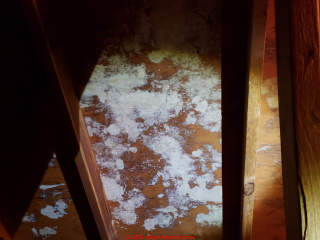 Mycelial cord, a discrete filamentous aggregation of hyphae which, in contrast to a rhizomorph, has no apical meristem; syrrota; - op cit.
Mycelial cord, a discrete filamentous aggregation of hyphae which, in contrast to a rhizomorph, has no apical meristem; syrrota; - op cit.
This photo of white mold shown on the under-side of this plywood roof sheathing was posted by an InspectApedia.com reader
at MOLD APPEARANCE on VARIOUS SURFACES and is discussed in our article.
It's possible that a closer examination of the white "stuff" on this plywood will find that we are looking at thick mycelial growths of a fungus.
At ATTIC MOLD, WHAT IT LOOKS LIKE we address a remediator's assertion that they could identify the white mold genera in this photograph as Aspergillus by sight alone.
Most white building molds can not be reliably identified to genera/species without microscopic analysis by a qualified aerobiologist/microscopist in a test lab.
Article Contents
- WHITE MOLD & FUNGUS PHOTOS Identification photographs of white mold & rot on indoor surfaces
- WHITE & OTHER MOLDS in DUCTWORK
- WHITE FUNGUS GROWTH in INSULATED WALL
- WHITE FUNGAL GROWTH on WOOD DECK JOIST - flat white, peels off
Identification Photographs of White & Light-Colored Mold Growth in Buildings
Here are photographs of both obvious white mold & fungal growth in buildings and also more difficult to see white or light gray mold growth on building surfaces.
Above we show white mold growth on tongue and groove subflooring in an older home in the northeastern U.S.
Below we see extensive white fungal growth (white mold growth) on OSB subflooring and on a floor joist over a wet crawl space in New York.
When you see a white "fungus" or "mushroom" like structure you're seeing the fruiting body of some mold species.
Other white or light colored moulds in buildings appear as tiny white spots, even as white or gray or light-green "dust" as you'll see in our photographs in this article.
Light colored molds, depending on the genera species, may be more of a health risk than the infamous "toxic black mold" that people look for in buildings.
Fungal groups such as Penicillium sp. and Aspergillus sp. produce species in a wide range of colors, some of which can be quite light in color and difficult to spot on building surfaces, but these molds may produce small, easily-airborne toxic or pathogenic mold spores that present a health risk to building occupants.
White stuff that is not mold
Beware: many people mistake mineral salts or efflorescence for white mold. Efflorescence is a white crystalline salt left on masonry surfaces where water or moisture have been evaporating.
See STUFF THAT IS NOT MOLD for photos of white fluffy material or white crystalline material that is often mistaken for mold.
Above we show white mold on wood subflooring and on OSB subflooring in a wet crawl space. Below we show additional photos of white and light colored molds found in buildings.
The white mold growing on this basement door was hard to spot without careful use of lighting. It looks almost like white dust, but unlike settled dust, a closer look at the mold-suspect surface will show growth patterns of the fungus and a relationship between the mold location and moisture or water exposure.
Dust tends to be more uniform over a specific building surface whereas mold on building surfaces tends to grow in colonies such as shown in our white mold on paneling photo below.
The white mold growing on this basement stairwell paneling was impossible to see until we directed our flashlight across the surface.
Read LIGHT, FLASHLIGHT for MOLD - proper use of a flashlight can help spot mold on paneling and other building surfaces.
Also see how LIGHT AIM FINDS MOLD & OTHER PARTICLES.
Here is a photograph of white mold that was very easy to see (and possibly some light-green mold) on yellow pine tongue and groove roof sheathing visible in the attic of an older home in the Northeastern United States.
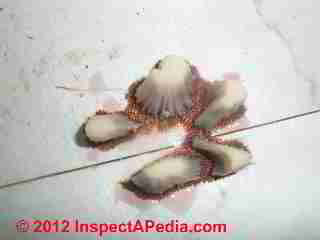
White mold that turns brown - Eg: Stemonitis sp.
Here is a photograph of a white fungus found growing on resilient flooring in an Australian bathroom. This fungus was very easy to see but was for a time a bit curious.
Covered and kept moist for just a brief interval, this Stemonitis sp. matured into an easily recognizable form of brown slime mold that we illustrate and discuss
at MOLD SAFETY ADVICE for TENANTS
and also in more detail
White mold that turns green, red, yellow, brown, tan, orange - eg. Aspergillus sp.
[Click to enlarge any image]
Aspergillus occurs as about 180 different sub-species (some sources list 250 species) of which about 20 are commonly found on building surfaces. ( US CDC www.cdc.gov/fungal/diseases/aspergillosis/causes.html )
The Aspergillus Taxonomic Scheme generously provided above by Janet Gallup, EMLaboratory, shows that while there are light colors of species of Aspergillus, most of its species are more-exciting in their pigment.
The color of common Aspergillus mold colonies in buildings ranges from black or very dark brown (A. niger) through greens, yellows, tans.
A brand new Aspergillus colony may appear as a white growth but usually when we see species of Aspergillus on a building surface it's not brand new (hours to days old) and it's got color. Photo above: a mold colony growing in culture, photographed by the author [DF] at McCrone Research Institute in 2003.
As the Aspergillus colony matures it darkens to green, green-gray, or green-brown with a white apron at the margin, very much depending on the species of Aspergillus and possibly as well as on what the Aspergillus has to eat - what material it's growing upon.
White Mold Growth on the Interior Surface of Fiberglass-lined HVAC Ducts
[Click to enlarge any image]
Above: white "growth" found on the interior surface of fiberglass-lined HVAC ducts in a home in Atlanta, GA in 2016. Look closely to see the presence of clear adhesive tape being used to collect a sample from this surface to permit laboratory analysis.
Samples from this fiberglass duct were examined in our InspectApedia.com forensic laboratory.
Below: an example of lab test results included these:
Above first photo, sample 2, Aspergillus sp. conidiophore (photo center) and hyphae at upper left corner of the image. Above second photo sample 2, Cladorporium sp. in dense fungal growth on the surface.
Details of this air duct mold contamination study based on clear adhesive tape samples of the mold-suspect surface of the air duct are found
at FIBERGLASS AIR DUCT MOLD TEST.
Below: another example of white mold found in HVAC air ducts, on the duct fiberglass insulation. The photo below was posted originally at MOLD APPEARANCE on VARIOUS SURFACES
Also see AIRBORNE PARTICLE & MOLD LEVELS in DUCTWORK.
White Mushroom-like Fungus Growing In Insulated Crawl Space Wall Cavity
Question: is this white stuff efflorescence or mold?
Hi, while cleaning out the 4 foot crawlspace of my split level house I noticed a black patch a foot long on the drywall.
Decided to remove it and look behind. Found a white crystal-like substance on all the 2x4s. In one spot it looks like it is growing away from the 2x4 onto the vapor barrier in a oyster shell shape.
This is an outside wall, insulated with fiberglass and covered in drywall. It also is where the water pipe is located for the outside use.
The lower right corner shown below has a lot of dark patches on the wood. We've owned 10 years and never had any water leak. Any way I can attach or send a photo? Thank you.
Here [are more photographs] of the white stuff on the 2x4s in my insulated crawlspace.
This is a horizontal 2x4 at head height (ceiling of crawlspace which is under floor for the living room on top). It has rather thick white growth as well as branches reaching out making contact with the vapor barrier.
I can see that all 2x4s within a 4ft area have this. Suspect condensation from copper pipe leading through here to exterior has created sustained dampness. House built in 1995.
Thanks for identifying the white stuff, if at all possible. I want to see if it's safe for me to remove all remaining drywall, vapor barrier and insulation in order to find the issue, and clean the area. I'm hesitant to let the white stuff "breathe" out in the air without knowing for sure what it is.
The only local mold expert said in 40 yrs never seen white stuff I am describing, so he said no use he comes out. - Anonymous by private email 2016/11/09
This question appeared originally
at MOLD APPEARANCE - STUFF THAT IS NOT MOLD
Reply: what to do about mushrooms growing in a building wall
Those photos look like white mushrooms growing in your wall, on wood surfaces. That's not efflorescence
Typically basidiomycetes or wood-rotting fungi grown on wet wood and can appear rather quickly even indoors in wet conditions, so I cannot guess from the white fungus how long this problem has been going on.
These fungal fruiting bodies may appear in any of many colours, commonly brown, white, red, even blue or very dark, almost black. More examples of mushrooms growing in or on buildings are
at BROWN MOLD PHOTOS
and
at MOLD on DIRT FLOORS - separate article, includes white mold on dirt in crawl spaces & basements
When you can I'd like to see also a couple of more-distant shots of the wall to see the situation as well as to see photos of the same sides of the building from outdoors.
You should
- Investigate further: Expect there to be other mold present, both visually obvious and not.
The wet conditions that caused this fungal growth are likely to also have invited other mold genera species that do not produce large white basidiomycete fruiting bodies which is what your photos seem to display.
I'd like to see photos of the material when the plastic is removed.] You should also inspect and probe the wood structure for rot.
More help is
at HIDDEN MOLD, HOW TO FIND - Remove the mold and fungal growth: Plan to remove all visibly moldy material such as insulation.
You can reduce personal risks by wearing protective clothing, a HEPA respirator, goggles, etc., and you can reduce the chances of blowing moldy dust into the upper, occupied part of your building by creating negative air pressure in the crawl space - a professional would seal off the area and install one or more air handlers or fans blowing "out" of the crawl space.
More help is
at MOLD ACTION GUIDE - WHAT TO DO ABOUT MOLD.
I do not think you need to "test" for mold when a fungus is plainly visible. - Remove other moldy materials that cannot be cleaned: Remove any nearby insulation and any insulation that was wet, to a stud bay or 18" space of clear un-contaminated, dry, clean insulation or material.
Watch out: be alert for discovery of a large area of mold contamination. If you find more than 30 square feet of visibly contiguous mold growth then it's probably time to hire a professional.
See MOLD / ENVIRONMENTAL EXPERT, HIRE ? - Clean and dry the area: Clean the exposed cavity and let it dry before re-insulating and restoring the wall.
- Re-Insulate & repair damage: in my opinion, using fiberglass insulation below ground in an area likely to be wet or exposed to high humidity invites mold problems in the future. I'd consider a closed-cell foam insulation as an alternative.
- Fix the cause of mold growth: Find and fix the source of water entry so that it doesn't recur. I suspect that there has been water entry into your wall or crawl space.
See CRAWL SPACE DRYOUT
Reader Comments, Questions & Answers About The Article Above
Below you will find questions and answers previously posted on this page at its page bottom reader comment box.
Reader Q&A - also see RECOMMENDED ARTICLES & FAQs
On 2022-08-20 by Mike Ghallis
@InspectApedia-911, Okay thank you kindly for your quick response!
On 2022-08-20 by InspectApedia-911 (mod)
@Mike Ghallis,
Looks like the paper facing on drywall.
On 2022-08-20 by Mike Ghallis
Hi, I have this in the walls at my house. Can you identify the brown material? The home was constructed in 1962 .
On 2022-08-15 by InspectApedia-911 (mod)
@Tasha,
We understand that when one becomes anxious it's too easy to see a mold-enemy under every bush.
I recommend reading
MOLD / ENVIRONMENTAL EXPERT, HIRE ?
On 2022-08-15 by Tasha
@InspectApedia-911, Thank you very much for your resource and expertise. I’ve thrown a lot of indoor/outdoor observations at you; I think it was a reflection of my brain operating on overdrive trying to connect many dots.
I was wondering (out loud, I suppose) whether our indoor observations might be related to a dry rot fungus… and whether that dry rot has spread to the soffit… and whether, in turn, those spores were released from the soffit and happened to land on the lids of the garbage cans.
All theoretical, I know, and completely impossible to determine from a single photo. :)
I think I was hopeful if the white fungus were something easily recognizable to an experienced eye, it might provide me with a clue to the bigger puzzle. (I know lab testing is the only way to positively identify)
I am looking for a lab that can test a fungus sample from our subfloor for S. lacrymans or P. incrassata.
A very long and winding train of thought, when I could have simply asked “the crystal pattern in this mold seems unusual, have you ever seen anything like it before?”
Thank you for taking the time to provide feedback, and thank you very much for this amazing resource!
On 2022-08-14 by InspectApedia-911 (mod) - growing fungus or fruiting body of mold indicates water and leaks
@Tasha,
Those long thin dark streaks form a pattern that does not look like mold growth. When you see a fungus or fruiting body of mold growing out of a crack on an interior wall you know that the space behind that spot has been wet and that therefore there must be leaks in the building.
On 2022-08-13 by Tasha
 Soffit (dry rot/fungus?) Why the reddish color?
Soffit (dry rot/fungus?) Why the reddish color?
I see other areas in/outside that also look like this, but white. A lot of this above interior crown molding.
I see other areas like this, only yellow, under interior door frames. Those areas look like they’ve been that way for a long time, and the yellow is hard, like cement. I’ll post another question about that under poria.
On 2022-08-13 by Tasha
I thought perhaps I should post a picture of the soffit. This is not the section right above the moldy garbage can, but just a few feet over- it all pretty much looks like this now.. I’ll post a couple more.
Maybe I’m not remembering accurately, but I swear this whole area was completely white and smooth just a few months ago. I think you can also see beetle exit holes in a couple of these.
On 2022-08-13 by InspectApedia-911 (mod) - white fungal mycelia
@Tasha,
It does look like a white fungal mycelia is growing on at least some of those surfaces.
All mold is everywhere, outdoors, and grows on surfaces of various materials when conditions of moisture, temperature, and other factors are comfortable for a particular mold genera/species.
You can clean those surfaces or toss out moldy materials found outdoors. You can not expect nor create a mold-free outdoors but you can reduce mold growth on household materials or surfaces, such as by controlling roof runoff or moving items like a (now cleaned-off) plastic garbage can into a sunny area.
Outdoor mold won't be a factor in an indoor humidity nor mold complaint.
For indoor mold issues see MOLD ACTION GUIDE - WHAT TO DO ABOUT MOLD
and
HUMIDITY CONTROL & TARGETS INDOORS
On 2022-08-13 by Tasha
 Here’s one more photo from under the carport- this is a black tarp draped over a wagon. I also see THIS type of white powder, in this pattern, everywhere INSIDE my home. I saw it inside weeks before seeing this now outdoors. Also, in my first comment and photo of the green garbage can lid, you can see drops of water- the drops and puddles of water are all over inside the house, too. Always near where there is white dust.
Here’s one more photo from under the carport- this is a black tarp draped over a wagon. I also see THIS type of white powder, in this pattern, everywhere INSIDE my home. I saw it inside weeks before seeing this now outdoors. Also, in my first comment and photo of the green garbage can lid, you can see drops of water- the drops and puddles of water are all over inside the house, too. Always near where there is white dust.
On 2022-08-13 by Tasha
I moved into a home that has felt “damp” since we moved in (March 2022). As background, the owners of the home moved out about a week before we moved in. They claim they did not experience dampness or humidity while they were living in the home.
I do believe this to some degree- I have experienced consistent relative humidity nearing 70% in the home, and I don’t believe they would have lived here under those conditions. Based on what I’m now finding, I think there was probably some existing dampness and higher-than-normal humidity, but it’s possible they may not have noticed that if they weren’t looking for it.
(I had a mold exposure 15 years ago which led to some health issues- so I am now very mindful regarding indoor air quality, humidity/leaks and risk of mold).
I can’t figure it out, but it would seem that *something* happened to cause the indoor humidity and overall dampness to skyrocket. There are no obvious leaks- verified by a plumber, roofer, and a disaster remediation guy who came out with a moisture meter and IR camera.
I was sure that camera was going to find our hidden water source, but alas, no. The house is at the bottom of a slope, so that is not ideal, but landscape drainage, gutters, etc seem adequate. Nothing obvious there. In addition, the indoor moisture levels are unchanged in stretches of wet or dry weather.
There was some work done in the front yard between the time the owners moved out and we moved in. I believe it was sewer-related; I THINK removing some tree roots; not sure. I will also note our tap water (every tap, even on cold water, including the washing machine, toilet tank, and ice maker) was dark rusty BROWN when we moved in. Neighbors were not having this issue.
The city came twice and flushed the water line. That helped- some. Our water has been some shade of light orange to light yellow ever since. On some days when it’s worse than others, it smells “earthy”, or sometimes like iron (we live in Georgia- our soil is red clay). The hot water heater is <3 years old and working fine. plumber said all the pipes look fine. there is no sewer smell. when there is a smell, it’s more like wet dirt.
i promise i’m getting to the point and i do have a question about white mold/fungus for this page :)
over the past couple months, i have noticed what seem to be powderpost beetle holes in walls, floor, and ceiling. i also kept sweeping up round white balls that google image search told me were powderpost beetle eggs. then for a few weeks, i kept finding (and stepping on) tiny ivory crescents that another google image search told me were powderpost beetle larvae.
so i read about powderpost beetles, which led me down the rabbit hole to water-conducting fungi. wow, maybe that explains our dampness source??? especially if it’s under the floor???
so i went down to the unfinished basement/crawl space to look around. (there is ventilation and vapor barrier). i’ve been running a dehumidifier down there since we moved in, which has kept it at a consistent 45%. i saw a small section of active larvae in one beam- though i can’t find any evidence of them now.
i see what looks like old dry rot. i see a lot of sticky yellow stuff on the basement ceiling (subfloor?). also a lot of drippy white and grey… something? and a couple of mushrooms. and what looks like some other type of puffy fungus growing in crevices. and possibly lichen(?) on the granite/mortar walls. it doesn’t feel damp or smell musty down there. but it is very dusty.
there is a lot of orange dust but i can’t tell if it’s spores or georgia clay or both. the hvac (new, recently checked, working fine) is down there, as is all the (very old!) ductwork. i did have the ducts cleaned by a reputable company when we moved in.
i will note that my child and i have had intense allergy symptoms since moving in to this home. mine are particularly severe; regardless of whether we ever find out what is going on with this house, i don’t think i will be able to live here.
i have more questions for other threads (like the poria/serpula page) but (finally!) i get to my question about white fungus…
the soffits seem to have deteriorated greatly since we moved in. last week, i noticed the garbage cans, which we keep under the carport, were covered in fine yellow dust. this week, i noticed the fine yellow dust has morphed into frost-like fungus/mold and a white green/blackish mold.
i wondered if this could be serpula or poria because of the yellow spores that preceded it, and because the soffit above looks like it’s now rotting. but this is plastic! not wood. granted, the plastic probably has a layer of dust/ dirt that might be food for fungus?
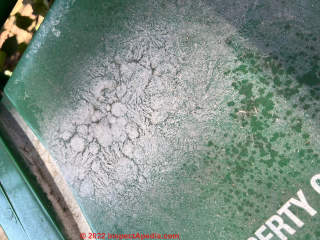 ...
... 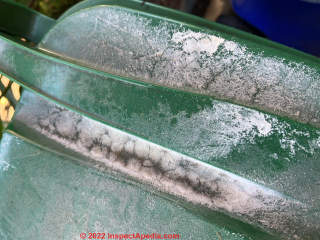
anyway- what is this? can it help us identify our humidity/ mold/ moisture mystery?
I also see mysterious, random drops of water on the hardwood floors. The water is not dripping from above. Since reading about water-conducting fungus, I now wonder if the drops of water could be coming from below? I’ll post a photo of the water drops in another comment, probably under the poria/serpula topic…?
On 2022-07-06 by InspectApedia-911 (mod) - fungal growth on wood
@April,
Sorry that I can't give an absolute answer but the photos a bit blurry. I suspect that might be the mycelial body of a fungal growth on that woody service but I can't really see enough to be certain.
On 2022-07-05 by April
Is this mold? Or dirt? What about the white stuff? This is the bottom of a wood tile I pulled up.
On 2022-01-23 by Inspectapedia Com Moderator
@angela,
I can't be certain from your text alone, but that certainly sounds like it could be mold.
On 2022-01-22 by angela
Should I be concern; Cleaning out the bottom of my closet felt damp but saw no water anywhere but look at my shoes and purses. They had actually taken a different shape and this white dust all over. My sweaters that had fallen off the hanger smells like mildew. Is this mold starting?
On 2021-10-11 by inspectapedia.com.moderator - cabinet mold source needs investigation
@Kat,
If your house is wet or damp enough that you're seeing white mold growth on the front of cabinets you definitely need to do some investigating to find and correct the cause as well as to clean or remove the mold and inspect for leaks or hidden mold in building cavities.
On 2021-10-11 by Kat
Anything I should be worryed about?

Question: what is this white stuff on our 25-year old Wood Deck Joist? Mold?
This discussion has been moved to
On 2021-06-27 by inspectapedia.com.moderator (mod) - what to do about white mold on plywood in a building
 @Anonymous,
@Anonymous,
The 1-2-3 of taking care of mold in or on building surfaces
The only justification for sawing and removing moldy wood is if it is rotted or damaged so that it can't do its job.
1 - Clean the surfaces (remove the mold) as much as you can; stains in the surface of wood will be harmless.
2 - Seal the surface (optional)
3 - Fix the cause of mold growth: leaks and moisture
Please see ACTION GUIDE - WHAT TO DO ABOUT INDOOR MOLD - https://inspectapedia.com/mold/Mold_Action_Plan.php
On 2021-06-27 by Anonymous
@inspectapedia.com.moderator,
What is your suggestion to take care of this? Its very odd because its ingrained in the wood, its not raised or bumpy. I could definitely remove this as it is just a storage structure in my basement. Should I have it remediated or do you think I could saw around the edges and remove?
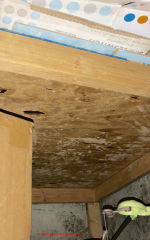 On 2021-06-26 by inspectapedia.com.moderator (mod)
On 2021-06-26 by inspectapedia.com.moderator (mod)
@anon:
Yes that looks like a light-coloured mold.
On 2021-06-26 by Anon - does this white stuff under my shelving look like mold?
Here is a second photo
RE-posting from private email:
Anonymous asked:
I just found your site and having trouble matching a photo to what I see in my basement. So this is on the underside of some storage shelves in my basement. They are plywood. Does this look like mold or fungus or?
On 2021-02-12 by Tara Strunk - is this white stuff on my door moLD?
Re-posting from private email:
Reader Anon asked:
Tara Strunk <phoenix_77788@yahoo.com>
9:58 AM (1 hour ago)
to editor
I recently moved into an apartment and found mold in many places. A remediation company cleaned the apartment
I’ve noticed white spots in the door in the bottom photo. I am wondering if this is damaged substrate or mold re-growth. How can I tell?
Moderator reply:
Sorry but I can't say for sure what's in your photos, but certainly the area is trivial in size; Use any household cleaner and clean those surfaces. Spray cleaner and paper towels should be sufficient.
Typically mold growth on surfaces will look like that shown in the photos above on this page where we have included various photographs of white or light-coloured moulds.
Also you might distinguish mold growth by its patterns: a mold spore lands on a surface that's sufficiently damp, and if it's happy there, grows outwards from a single point, forming a colony, often round in shape.
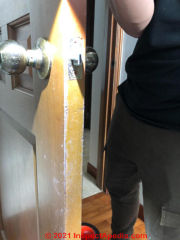 By contrast, white specs of drywall dust, also soft and easily smeared (like mold) will be more uniform in its distribution on a surface if it landed there, for example, as settled drywall dust during sanding of or other drywall or gypsum board work.
By contrast, white specs of drywall dust, also soft and easily smeared (like mold) will be more uniform in its distribution on a surface if it landed there, for example, as settled drywall dust during sanding of or other drywall or gypsum board work.
Often if we examine "white specks" like those in your photos, using a simple 10x magnifying glass, we can recognize that the material is inoragnic (like drywall dust) or that it is made of lint-like filaments (fabric fibres).
Un-addressed, but hinted at in your question is the matter of what previous mold contamination was present and how correctly that has been addressed.
If your apartment was previously considered sufficiently mold-contaminated as to merit cleaning by a professional mold remediation company (more than 30 sq.ft. of contiguous moldy material in one or more places) then the correct approach would have involved
- an independent inspection by an unbiased expert to define the apparent scope of work required
- a cleanup company who removed the mold, identified its cause and fixed the cause as well
- a follow-up independent inspection to confirm that the work was properly-performed
On 2020-12-19 - by (mod) -
Efflorescence
On 2020-12-19 by Anonymous
On 2020-12-08 - by (mod) - Bleaching or trying to "Kill" mold is another basic error
Sorry Ed, the confusion is my fault: when I keep posted questions or comments by moving them up into the body of the article on this page, then the "Comment" box features don't show up there.
You are of course always welcome to post new comments or questions at page bottom just exactly has you have done.
Cleaning Aspergillus or Penicillium with a shop vac is not a great idea because the spores can be so small - down in the 1u range - that they pass right through a typical shop vac filter and you're simply aerating them - blowing them all over the space.
Running an ozone generator is a popular but not best practice as well; there is a real risk of over-dosing with ozone, oxidizing building contents, and creating a new smell that is only fixed by throwing stuff out.
See OZONE MOLD / ODOR TREATMENT WARNINGS https://inspectapedia.com/sickhouse/Ozone-Treatment-Warnings.php
Bleaching or trying to "Kill" mold is another basic error Anon-
See MOLD CLEANUP, BLEACH https://inspectapedia.com/mold/Bleach_Mold_Contamination.php
You can't kill all the mold, and even if you did, you may well be leaving "dead" spores (they won't grow) that are still toxic. Mycotoxins are still present.
Using fans to dry out an area is often a good practice, and one I'd use but NOT in an area that's still mold-contaminated, as we're blowing mold all over the place, creating a work-area hazard, and possibly sending some of the mold upwards into other nearby building areas; Where professional mold remediators use fans it's usually blowing them to the outdoors - creating negative air pressure in the work area so as not to spread mold in the building
The right approach to getting rid of mold contamination
- Remove the mold by cleaning
- Throw out stuff that can't be cleaned - soft goods, insulation, drywall
- Clean the exposed surfaces - don't worry about remaining stains "in" the wood
- Optional: use a fungicidal sealant to reduce future moisture-uptake and thus mold friendliness
- And
Find and fix the original cause of mold growth
On 2020-12-08 by Ed
Sorry but I cannot find the reply button on my previous comment on On 2020-11-12 by Ed.
I had the mold sampled and it is Aspergillus sp /Penicillium sp.
I cleaned the boards with shop vac that was outside the home with only long hoses coming into the home. Now the boards look clean but you can still see a white stain on some of the heavier spots.
I am attempting to run an ozone generator in the area which is 1100 square ft. I am using 14000mg/hr and have only run it twice, once for 1hr and then again for 2hr. I have some people telling me this is no threat and then some telling me it's a major health risk. I really don't know my risk.
Should I now use a 20% bleach solution and spray on the boards then also a rinse (all of which will be adding moisture to the basement) or would the bleach spray be OK without a rinse? Then maybe just run a bunch of fans to try and dry everything?
Any comment will be appreciated. Thanks - Ed
On 2020-12-03 by (mod)
Michelle
I can't see mold in your photo, but if you smell mold, there's probably mold nearby even if this is something else. The pattern of white stuff in the upper portion of your photo doesn't itself look like mold;
Look for drywall that has been wet or for the history of leaks in the bathroom; investigate those areas.
On 2020-12-03 by Michelle
Bathroom smells musty, cut open drywall. Builder says it’s drywall dust?
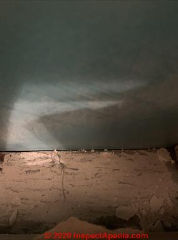
On 2020-12-01 - by (mod) -
Yes, looks like mold on a rim joist and on floor joists butting into the rim joist.
On 2020-12-01 by Ashley
Is this mold? This is a vertical outside wall.
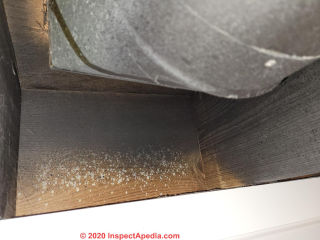
On 2020-11-28 - by (mod) -
Amber
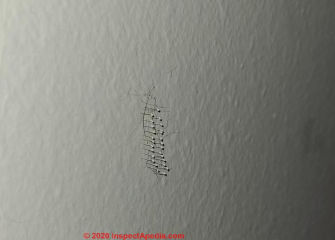 Thanks for an interesting photo of some paint disturbance on your ceiling.
Thanks for an interesting photo of some paint disturbance on your ceiling.
Perhaps you can look at it more closely with a magnifying glass to confirm that there is or is not human or insect hair or fabric or brush fibres in that location.
I don't know what it is but it looks almost as if a furry insect flew into and was stuck to the ceiling
. It would be helpful to know the scale: try another photo with a ruler included.
On 2020-11-28 by Amber - We found this on our wall, any one know what it is?
We found this on our wall, any one know what it is?
On 2020-11-12 - by (mod) - moldy subfloor at plumbing leak - identifying the species won't change the action plan
Ed:
No I can't identify the white material for certain by just this photo, though it looks like a fungus it's a bit fuzzy and light - not what we usually expect to see.
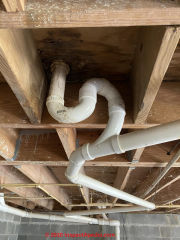
First we need to be sure there's no ongoing leakage at that funky drain trap.
Then you can use an HEPA vacuum cleaner followed by any household cleaner to clean those suspect surfaces.
Before doing so, if you want to confirm that that white stuff is mold (I suspect it is) you might try collecting a simple adhesive tape sample to send to a mold test lab.
It's easy and inexpensive: see TAPE & BULK SAMPLING & TESTS for MOLD for an explanation or
see TEST KIT for DUST, MOLD, PARTICLES: INSTRUCTIONS for a more-detailed procedure using this particle sampling method.
On the other hand, if knowing it's mold isn't going to change what you're going to do with it, you could skip testing.
On 2020-11-12 by Ed
Hello, can you help me determine what I should do about the white spots seen in the attached photo? It is in a daylight basement that did have a water issue in the past.
This stuff will just flake off and if you just bang on a rafter, some of it will fall to the ground. If it is not readily identifiable by the pic and it should be sampled, how should I collect a sample and where should I send it too? Thanks for any help you can give.
On 2020-07-11 - by (mod) -
Sorry but no, Matt; one cannot give the genera and species of a mold or fungus on wood from only an image of the growth; the mold would need to be examined microscopically;
Most likely there will be more than one genera/species present;
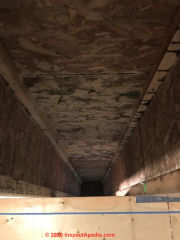 Luckily the mold genera/species identification is not necessary in that it won't change what's needed.
Luckily the mold genera/species identification is not necessary in that it won't change what's needed.
Remove the mold, clean the surfaces,
Find and fix the cause of mold growth.
If the OSB itself is not soft, delaminating, damaged, I'm of the opinion that there's no justification for its replacement; clean the surfaces; AFTER cleaning and correcting the cause, you might like sealing with a fungicidal sealant as well.
See FUNGICIDAL SPRAY & SEALANT USE GUIDE
Watch out: just to be clear, that black stuff that was running down the edge of the top of an I-joist is adhesive, not mold. The rest of your photo is a bit blurry so I'm uncertain what's present.
On 2020-07-11 by Matt
Any idea what type of mold this is on a brand new construction in the crawl space.
There is one full 4x8 sheet of OSB that looks like this. Nothing else going on in the crawl space and the water is not actually turned on.
Building is almost complete so to replace the sheet would be a significant task. Should the sheet be treated for mold or replaced entirely?
On 2019-11-15 - by (mod) -
A couple of points that may be helpful. Molds don't always smell. Vinegar or any other material that's used in an effort to kill mold is not the correct approach. The correct approach is to remove the mold and incorrect cause of its growth.
I can't tell if your description but it sounds like there may be in fact some mold growing on things in your friend's home. If you're not sure they could easily enough have a little sample tested.
On 2019-11-15 by Aja
Oh wow I have several questions. I was at someone’s house who had like a white/light gray..I think it’s mold. It’s not that easy to see, I thought it was just dust at first. It’s kinda all over this one room. On some shoe boxes in the closet, not all.
On some of the shoes in the shoe boxes not all. On a few handbags that were in a bin in the closet. On some of the furniture in the room.
On her boyfriends baseball hats. Very strange because I’m the type of person that could smell mold or mildew anywhere even if it’s just a tiny bit of it. The other strange thing is that her house didn’t feel or smell humid.
No strange smells at all, not dirty or anything, not and old house, so it’s baffling. Wondering where it came from. I heard Vinegar should help kill it. Who could she call to diagnose it? Would an air purifier in the room help?
On 2017-06-01 1 by (mod) - how do you get rid of mold?
Cheryl,
At MOLD CLEANUP GUIDE
You will find step-by-step procedures to remove, clean up, or get rid of mold contamination in your home
On 2017-06-01 by Cheryl
How do you get rid of it
On 2013-01-09 by Mod - white mold dots and mold all over the place
That sounds as if you need to
- toss out paper or soft goods that can't be cleaned of mold
- clean hard surfaces, plastic containers,
- dry out the basement
- find and fix the water or moisture source
otherwise themold will simply return
On 2013-01-09 by KAREN MAXWELL
Hi. We have white mold dots all over the place, suddenly in our basement. On plastic containers .on the aluminum paperbacked furnace venting...on the plastic that covers the insulation and on pipes, etc. Also on the giant old wood beams.
This is a century home. I have been fining hyphae of some kind all over the house and in fact my antique furniture is filamenting.
The hyphae are attracted to light as well. I had an air quality guy here today who has no idea what mold is what. Meawhile, I have become very ill and so has my cat. Names of the mold species in the pics would surely help me. Thanks.
On 2012-02-14 by (mod) - get rid of white mold in the attic
Ian:
You need to
1. remove the mold - any household cleaner is fine
2. toss out any moldy insulation or drywall and clean the exposed surfaces
3. fix the cause of mold growth: leaks or trapped moisture or inadequate attic venting
On 2012-02-14 by Ian
I have found some, what I believe to be white mold in my attic. It looks like the picture of the white mold on the attic sheathing.
I had a problem with an exhaust fan in the bath room and the mold seems to be in just that area. It seems like with the different seasons it either goes away or comes back. Is this mold and what can I do to get rid of it because I am putting a room in the attic and my feeling is that I need to take care of this before I put in insulation and drywall.
On 2012-02-09 by Mod: "Sea urchin" like mold growingon window
You might be describing a brown hairy mold that is often identified as stemonitis.
See the photos at BROWN HAIRY BATHROOM MOLD
On 2012-02-09 by Anonymous
i found something that looks like a brown ball (almost like a sea urchin) growing outside by my moms bedroom window a few yrs ago i hit it with water and it went away just the other day i was in the basement n saw some more i didt use the hose this time but touched it with a long stick and it turned to dust what could this be?
i have been searching the web and can not find out what it could be is it mold?some 1 please help my mom is very sick and i dont need her gettin any sicker please help me
On 2012-02-02 by (mod) - can mold discolor carpet?
I'm not sure that mold exactly "removes" colour from carpeting but certainly it can and does change carpet color as mold-exuded chemicals and pigments stain the carpeting.
Some area rugs can be professionally cleaned of mold but wall-to-wall carpet that has been wet or moldy is usually removed and discarded.
On 2012-02-02 by Sue
Can white mould remove colour from carpet?
...
Continue reading at MOLD APPEARANCE - WHAT MOLD LOOKS LIKE or select a topic from the closely-related articles below, or see the complete ARTICLE INDEX.
Or see WHITE MOLD PHOTO FAQs - questions & answers posted originally on this page
Or see these
Recommended Articles
- CAR MOLD CONTAMINATION - examples of light and white molds on car interior
- EFFLORESCENCE SALTS & WHITE DEPOSITS - for examples of moisture-related white deposits that are not mold.
- HIDDEN MOLD in OTHER PLACES for details of this and other places to look for hidden mold in buildings.
- HUMIDITY CONTROL & TARGETS INDOORS for an example of white mould occurring in a U.K. home with venting & humidity questions.
- LIGHT AIM FINDS MOLD & OTHER PARTICLES - how to use your flashlight successfully
- LIGHT COLORED MOLD - more light coloured moulds besides white can be hard to spot
- LIGHT, FLASHLIGHT for MOLD - proper lighting shows up hard-to-spot mold
- MERULIPORIA HOUSE EATING FUNGUS
- MILDEW ERRORS, IT's MOLD
- MOLD APPEARANCE - WHAT MOLD LOOKS LIKE - a Photo ID Library for detection and identification of mold allergens on indoor building surfaces.
- MOLD APPEARANCE - STUFF THAT IS NOT MOLD
- MOLD GROWTH on SURFACES, PHOTOS
- ROT TYPES, BROWN SOFT WHITE
- WHITE MOLD PHOTOS
- WHY DOES MOLD GROW in INSULATION? that includes photos and test results examining suspected mold on the surface of fiberglass-lined HVAC ductwork.
Suggested citation for this web page
WHITE MOLD PHOTOS at InspectApedia.com - online encyclopedia of building & environmental inspection, testing, diagnosis, repair, & problem prevention advice.
Or see this
INDEX to RELATED ARTICLES: ARTICLE INDEX to MOLD CONTAMINATION & REMEDIATION
Or use the SEARCH BOX found below to Ask a Question or Search InspectApedia
Ask a Question or Search InspectApedia
Try the search box just below, or if you prefer, post a question or comment in the Comments box below and we will respond promptly.
Search the InspectApedia website
Note: appearance of your Comment below may be delayed: if your comment contains an image, photograph, web link, or text that looks to the software as if it might be a web link, your posting will appear after it has been approved by a moderator. Apologies for the delay.
Only one image can be added per comment but you can post as many comments, and therefore images, as you like.
You will not receive a notification when a response to your question has been posted.
Please bookmark this page to make it easy for you to check back for our response.
Our Comment Box is provided by Countable Web Productions countable.ca
Citations & References
In addition to any citations in the article above, a full list is available on request.
- Fungi, Identifying Filamentous, A Clinical Laboratory Handbook, Guy St-Germain, Richard Summerbell, Star Publishing, 1996, ISBN 0-89863-177-7 (English)
- In addition to citations & references found in this article, see the research citations given at the end of the related articles found at our suggested
CONTINUE READING or RECOMMENDED ARTICLES.
- Carson, Dunlop & Associates Ltd., 120 Carlton Street Suite 407, Toronto ON M5A 4K2. Tel: (416) 964-9415 1-800-268-7070 Email: info@carsondunlop.com. Alan Carson is a past president of ASHI, the American Society of Home Inspectors.
Thanks to Alan Carson and Bob Dunlop, for permission for InspectAPedia to use text excerpts from The HOME REFERENCE BOOK - the Encyclopedia of Homes and to use illustrations from The ILLUSTRATED HOME .
Carson Dunlop Associates provides extensive home inspection education and report writing material. In gratitude we provide links to tsome Carson Dunlop Associates products and services.


